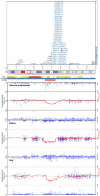Transmission of a Novel Imprinting Center Deletion Associated With Prader-Willi Syndrome Through Three Generations of a Chinese Family: Case Presentation, Differential Diagnosis, and a Lesson Worth Thinking About
- PMID: 34504512
- PMCID: PMC8421676
- DOI: 10.3389/fgene.2021.630650
Transmission of a Novel Imprinting Center Deletion Associated With Prader-Willi Syndrome Through Three Generations of a Chinese Family: Case Presentation, Differential Diagnosis, and a Lesson Worth Thinking About
Abstract
Prader-Willi syndrome (PWS) is a complex genetic syndrome caused by the loss of function of genes in 15q11-q13 that are subject to regulation by genomic imprinting and expressed from the paternal allele only. The main clinical features of PWS patients are hypotonia during the neonatal and infantile stages, accompanied by delayed neuropsychomotor development, hyperphagia, obesity, hypogonadism, short stature, small hands and feet, mental disabilities, and behavioral problems. However, PWS has a clinical overlap with other disorders, especially those with other gene variations or chromosomal imbalances but sharing part of the similar clinical manifestations with PWS, which are sometimes referred to as Prader-Willi syndrome-like (PWS-like) disorders. Furthermore, it is worth mentioning that significant obesity as a consequence of hyperphagia in PWS usually develops between the ages of 1 and 6 years, which makes early diagnosis difficult. Thus, PWS is often not clinically recognized in infants and, on the other hand, may be wrongly suspected in obese and intellectually disabled patients. Therefore, an accurate investigation is necessary to differentiate classical PWS from PWS-like phenotypes, which is imperative for further treatment. For PWS, it is usually sporadic, and very rare family history and affected siblings have been described. Here, we report the clinical and molecular findings in a three-generation family with a novel 550-kb microdeletion affecting the chromosome 15 imprinting center (IC). Overall, the present study finds that the symptoms of our patient are somewhat different from those of typical PWS cases diagnosed and given treatment in our hospital. The familial occurrence and clinical features were challenging to our diagnostic strategy. The microdeletion included a region within the complex small nuclear ribonucleoprotein polypeptide protein N (SNRPN) gene locus encompassing the PWS IC and was identified by using a variety of techniques. Haplotype studies suggest that the IC microdeletion was vertically transmitted from an unaffected paternal grandmother to an unaffected father and then caused PWS in two sibling grandchildren when the IC microdeletion was inherited paternally. Based on the results of our study, preimplantation genetic diagnosis (PGD) was applied successfully to exclude imprinting deficiency in preimplantation embryos before transfer into the mother's uterus. Our study may be especially instructive regarding accurate diagnosis, differential diagnosis, genetic counseling, and PGD for familial PWS patients.
Keywords: Prader–Willi syndrome; Prader–Willi-like syndrome; familial transmission; imprinting center; microdeletion.
Copyright © 2021 Zhang, Liu, Gu, Lv, Yu, Gao, Wang, Zhao, Li, Gai, Zhao, Liu and Yuan.
Conflict of interest statement
The authors declare that the research was conducted in the absence of any commercial or financial relationships that could be construed as a potential conflict of interest.
Figures





Similar articles
-
Three siblings with Prader-Willi syndrome caused by imprinting center microdeletions and review.Am J Med Genet A. 2018 Apr;176(4):886-895. doi: 10.1002/ajmg.a.38627. Epub 2018 Feb 13. Am J Med Genet A. 2018. PMID: 29437285 Free PMC article.
-
The changing purpose of Prader-Willi syndrome clinical diagnostic criteria and proposed revised criteria.Pediatrics. 2001 Nov;108(5):E92. doi: 10.1542/peds.108.5.e92. Pediatrics. 2001. PMID: 11694676
-
Influence of the Prader-Willi syndrome imprinting center on the DNA methylation landscape in the mouse brain.Epigenetics. 2014 Nov;9(11):1540-56. doi: 10.4161/15592294.2014.969667. Epigenetics. 2014. PMID: 25482058 Free PMC article.
-
Prader-Willi syndrome: reflections on seminal studies and future therapies.Open Biol. 2020 Sep;10(9):200195. doi: 10.1098/rsob.200195. Epub 2020 Sep 23. Open Biol. 2020. PMID: 32961075 Free PMC article. Review.
-
Prader-Willi syndrome: a review of clinical, genetic, and endocrine findings.J Endocrinol Invest. 2015 Dec;38(12):1249-63. doi: 10.1007/s40618-015-0312-9. Epub 2015 Jun 11. J Endocrinol Invest. 2015. PMID: 26062517 Free PMC article. Review.
Cited by
-
Prader-Willi syndrome patient with atypical phenotypes caused by mosaic deletion in the paternal 15q11-q13 region: a case report.Ital J Pediatr. 2022 Dec 29;48(1):204. doi: 10.1186/s13052-022-01398-0. Ital J Pediatr. 2022. PMID: 36582000 Free PMC article.
References
-
- Alaimo J. T., Barton L. V., Mullegama S. V., Wills R. D., Foster R. H., Elsea S. H. (2015). Individuals with Smith-Magenis syndrome display profound neurodevelopmental behavioral deficiencies and exhibit food-related behaviors equivalent to Prader-Willi syndrome. Res. Dev. Disabil. 47 27–38. 10.1016/j.ridd.2015.08.011 - DOI - PubMed
-
- Amos-Landgraf J. M., Ji Y., Gottlieb W., Depinet T., Wandstrat A. E., Cassidy S. B., et al. (1999). Chromosome breakage in the Prader-Willi and Angelman syndromes involves recombination between large, transcribed repeats at proximal and distal breakpoints. Am. J. Hum. Genet. 65 370–386. 10.1086/302510 - DOI - PMC - PubMed
LinkOut - more resources
Full Text Sources
Miscellaneous

